ENGINEER ACCEPTS CHALLENGE TO DESIGN LEGENDARY JEEP
Detroit, Michigan • July 17, 1940
As war clouds gathered over Europe in the late 1930s, the U.S. Army asked American automobile manufacturers to tender suggestions to replace its aging light-motor vehicles, mostly motorcycles and sidecars but also (incredible as it seems) some Ford Model Ts. As early as 1937–1938, several prototypes were presented to Army officials. However, Army requirements were not formalized until July 11, 1940, when 135 U.S. automotive companies were approached to quickly submit a design conforming to the Army’s specifications for an inexpensive, robust, four-wheel-drive reconnaissance or command vehicle.
On this date, July 17, 1940, a talented freelance designer from Detroit, Michigan, accepted the challenge. Five days later Karl Probst submitted a bid, complete with blueprints. A prototype, dubbed the “Blitz Buggy,” was hand-built in 49 days by the American Bantam Car Company of Butler, Pennsylvania, mostly using existing off-the-shelf automotive parts. Tested in September at the Army’s motor research and development facility outside Baltimore, Maryland, the vehicle failed only to meet engine torque criteria.
The blueprints, which the government claimed it owned under terms of the award, were turned over to Willys-Overland and Ford Motor Company. Both companies made design modifications, though the resulting prototypes looked similar to Probst’s “Blitz Buggy.” The War Department, requiring a large number of vehicles to be manufactured in a relatively short time, granted Willys-Overland the production contract to build the nearly 11‑ft-long, 4‑cylinder vehicle for $648.74 apiece. Ford, licensed to manufacture the vehicles using Willys’ specifications, produced 56 percent of all Jeeps made. Between them, Willys-Overland and Ford produced about 640,000 of the legendary general purpose (GP) vehicles, a number representing about 18 percent of all wheeled military vehicles built in the U.S. during World War II. (Poor Bantam was contracted to build the light trailer pulled by Jeeps.)
“The world’s greatest fighting machine” saw service as scout vehicles, communications vehicles, resupply vehicles, staff cars, and battlefield ambulances, among other utility chores. Versatile and rugged, these vehicles could transport 5 soldiers, carry 800 pounds of cargo, or tow a 37mm antitank gun. Typically, U.S. Army infantry regiments were outfitted with 149 Jeeps. In 1944 infantry glider regiments had 24 Jeeps and parachute regiments had 17, providing much-needed transport and weaponry behind enemy lines.
U.S. and German Military General Purpose Vehicles
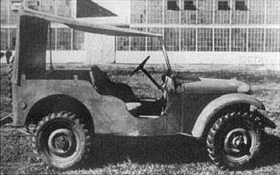 | 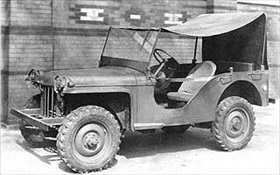 |
Left: The Bantam No.1 “Blitz Buggy,” the test vehicle delivered to Camp Holabird, Maryland, on September 23, 1940. “Old Number One” was the first vehicle of a 70‑vehicle contract between the U.S. Army and the American Bantam Car Company.
![]()
Right: The BRC40 4×4 Light Reconnaissance Vehicle, the final evolution of the Bantam design. Bantam built 2,765 of these nimble BRCs (Bantam Reconnaissance Cars), of which more than half went to the British Army, while some were sent to the Soviet Union. The term “Jeep” made its first appearance in print in late February 1941, after Willys-Overland staged a press event of its general purpose (GP, pronounced “jeep”) ascending the steps of the Capitol building in Washington, D.C.
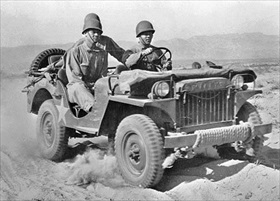 | 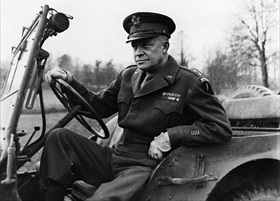 |
Left: Willys MA Jeep at the Desert Training Center, Indio, California, June 1942. Most MA Jeeps were sent to the Soviet Union under the Lend-Lease program. Indeed, the Soviets and the British were recipients of nearly one-third of all Jeeps built. Willys made its first 25,000 1/4‑ton, 60‑hp MB Jeeps (formally, Truck, 1/4 ton, 4×4) with a welded flat iron “slat” radiator grille. It was Ford that first designed and implemented the now familiar and distinctive stamped, slotted steel grille into its Jeeps. MB Jeeps were given other modifications, among them longer wheelbases, 6×6 drive trains, skis, armor plating, railway wheels, and pedestal mounts for various weapons, usually .30 or .50 caliber machine guns.
![]()
Right: Allied Supreme Commander Gen. Dwight D. Eisenhower behind the wheel of a Jeep, December 1944. Often referred to as “the wartime limousine,” the Jeep transported everyone from royalty to presidents and prime ministers, to generals and privates. Eisenhower remarked, “The Jeep, the Dakota (Douglas C‑47 Skytrain) airplane, and the landing craft were the three tools that won the war.” U.S. Army chief of staff Gen. George C. Marshall called the Jeep America’s greatest contribution to modern warfare.
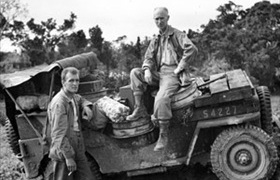 | 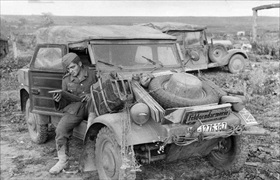 |
Left: War correspondent Ernie Pyle (seated) and jeep driver, Okinawa, April 10, 1945, 10 days before Pyle’s death by enemy fire on the island of Iejima (then known as Ie Shima) during the Battle of Okinawa. “Good Lord,” Pyle said, “I don’t think we could continue the war without the jeep. It does everything. It goes everywhere. It’s as faithful as a dog, strong as a mule, and as agile as a goat. It constantly carries twice what it was designed for, and keeps on going. It doesn’t even ride so badly after you get used to it.”
![]()
Right: A German Type 82 Kuebelwagen (literally, tub or bucket car) on the Eastern Front during Germany’s Operation Citadel, June 21, 1943. In January 1938 the Wehrmacht (German armed forces) approached renowned designer Ferdinand Porsche of Volkswagen Type 1 fame about designing an inexpensive, light-weight, on- and off-road military transport vehicle, suggesting that his Volkswagen Kaefer (we know it today as the Beetle) could provide the basis for such a vehicle. Full-scale production of the Kuebelwagen started in February 1940, over a year before Willys and Ford began delivering Jeeps to the U.S. Army in the spring of 1941. Between 1940 and 1945, 50,435 of these reliable and durable German vehicles with their rear-mounted, air-cooled engines were produced, including a Schwimmwagen version.
“Autobiography of a Jeep,” a 1943 Film Narrated by a Talking Jeep
![]()

 History buffs, there is good news! The Daily Chronicles of World War II is now available as an ebook for $4.99 on Amazon.com. Containing a year’s worth of dated entries from this website, the ebook brings the story of this tumultuous era to life in a compelling, authoritative, and succinct manner. Featuring inventive navigation aids, the ebook enables readers to instantly move forward or backward by month and date to different dated entries. Simple and elegant! Click
History buffs, there is good news! The Daily Chronicles of World War II is now available as an ebook for $4.99 on Amazon.com. Containing a year’s worth of dated entries from this website, the ebook brings the story of this tumultuous era to life in a compelling, authoritative, and succinct manner. Featuring inventive navigation aids, the ebook enables readers to instantly move forward or backward by month and date to different dated entries. Simple and elegant! Click 











